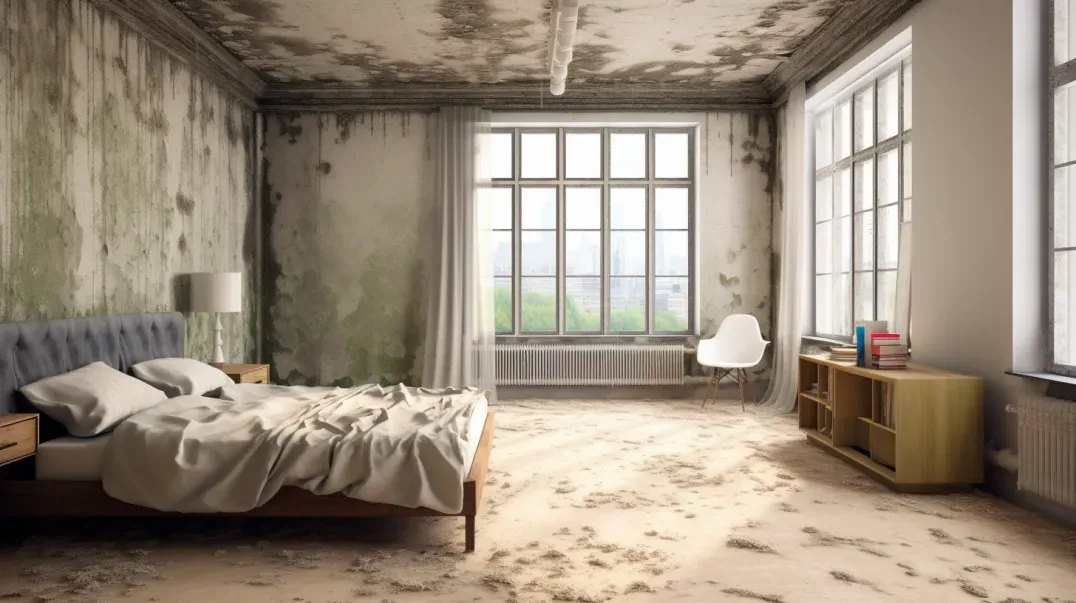Air Purifiers and Dehumidifiers: Tools in Mold Prevention
In the quest for a healthier living space, the quality of the air we breathe indoors plays a pivotal role, often serving as the unseen backbone of our well-being. Yet, lurking within the very air that surrounds us, factors such as humidity levels and air quality can silently pave the way for unwelcome guests - mold spores, waiting for the perfect conditions to thrive. This blog delves into the intricate relationship between indoor air quality, humidity, and the proliferation of mold, shedding light on why understanding and controlling these elements is essential for preventing mold growth and ensuring a safe, comfortable home environment.
Mold growth is not just a matter of aesthetics; it's a health concern that can have far-reaching effects on our respiratory system, allergies, and overall health. The key to mold prevention lies in managing the delicate balance of indoor air quality and humidity levels. By exploring the science behind moisture and air circulation, we equip you with the knowledge and strategies needed to tackle mold at its root, ensuring your indoor spaces remain healthy and mold-free.
Join us as we navigate the complexities of indoor environments, offering insights into how simple changes in humidity control and air quality management can make a significant difference in your home's health and your quality of life. Whether you're a seasoned homeowner, a new renter, or simply seeking to create a healthier living space, understanding the role of indoor air quality and humidity in mold growth is the first step towards breathing easier and living better.
The Science of Mold Growth in Indoor Environments
Mold is a ubiquitous part of the natural environment, playing a crucial role in the decomposition of organic matter. However, when mold spores enter indoor environments and find favorable conditions, they can grow, spread, and pose health risks to occupants. Understanding the science behind mold growth in indoor environments is key to preventing its occurrence and protecting your health.
Conditions that Promote Mold
Mold growth indoors is primarily fueled by two factors: humidity and the presence of mold spores in the air. Here's how these elements contribute to mold proliferation:
- Humidity: Mold spores need moisture to grow and reproduce. High humidity levels, typically above 60%, provide the perfect environment for mold spores to settle and thrive. Sources of indoor moisture can include leaking pipes, condensation, or high humidity from outdoor air.
- Airborne Spores: Mold spores are present in the air both outdoors and indoors. When these spores land on damp surfaces indoors, they can start to grow and form new mold colonies. The key to preventing mold growth is to control indoor humidity levels and ensure that potential moisture sources are promptly addressed.
By maintaining indoor humidity levels below 60% and addressing leaks or condensation issues quickly, you can significantly reduce the risk of mold growth in your home.
Health Implications of Mold
The presence of mold in indoor environments can have various health implications for occupants, ranging from mild to severe, depending on the individual's sensitivity and the duration of exposure. Here are some of the health risks associated with indoor mold:
- Allergic Reactions: Many people are allergic to mold spores. Exposure can lead to symptoms such as sneezing, runny nose, red eyes, and skin rash. Asthma attacks can also be triggered in people with asthma who are allergic to mold.
- Respiratory Issues: Prolonged exposure to mold can cause respiratory problems, even in people who are not allergic to mold. Symptoms can include coughing, wheezing, and difficulty breathing.
- Severe Health Effects: In some cases, exposure to certain types of mold, such as Stachybotrys chartarum (black mold), can lead to more severe health issues, including lung infections.
Understanding the potential health risks associated with mold exposure underscores the importance of preventing mold growth in indoor environments and taking prompt action to remediate any mold issues that arise.
Understanding Air Purifiers
Air purifiers are an essential tool in maintaining indoor air quality, offering a line of defense against pollutants, allergens, and, notably, mold spores. By understanding how air purifiers work and what factors to consider when choosing one, you can significantly enhance your living environment's health and comfort. This section explores the technology behind air purifiers and provides guidance on selecting the right air purifier for mold prevention.
How Air Purifiers Work
Air purifiers clean the air by passing it through a series of filters that capture and remove particles, including mold spores, dust, pollen, and other airborne contaminants. Here's a closer look at the technology behind air purifiers:
- HEPA Filters: High-Efficiency Particulate Air (HEPA) filters are a key component in many air purifiers. They are designed to capture 99.97% of particles that are 0.3 microns or larger in diameter, effectively removing mold spores from the air.
- Activated Carbon Filters: While HEPA filters capture physical particles, activated carbon filters absorb odors and gases, providing an additional layer of air purification.
- UV Light: Some air purifiers include UV light technology, which can kill mold spores and bacteria. However, the effectiveness of UV light in air purifiers can vary, and it should be considered as a supplementary feature rather than the primary method of mold spore removal.
Understanding how air purifiers work is crucial in choosing a device that can effectively contribute to mold prevention in your home.
Choosing the Right Air Purifier
Selecting the right air purifier involves considering several factors to ensure it meets your specific needs for mold prevention. Here are key factors to consider:
- Filter Type: Look for air purifiers with true HEPA filters, as they are most effective at capturing mold spores. Ensure the purifier is equipped with a genuine HEPA filter, not a "HEPA-like" filter.
- Room Size: Choose an air purifier that matches the size of the room where it will be used. Air purifiers are rated for different room sizes, so selecting one that's too small for your space may result in ineffective air purification.
- CADR Rating: The Clean Air Delivery Rate (CADR) measures how quickly an air purifier can clean the air within a particular room size. A higher CADR rating indicates more efficient air purification, making it an important factor in your selection process.
By considering these factors, you can choose an air purifier that effectively removes mold spores from the air, contributing to a healthier indoor environment and aiding in mold prevention efforts.
The Role of Dehumidifiers in Mold Prevention
Mold thrives in moist environments, making high humidity one of the primary catalysts for its growth in homes. Dehumidifiers play a crucial role in mold prevention by maintaining a healthier indoor humidity level, thus creating an environment that is less conducive to mold growth. This section explores how dehumidifiers help prevent mold and provides guidelines for selecting the right dehumidifier for your space.
How Dehumidifiers Help Prevent Mold
Dehumidifiers work by removing excess moisture from the air, thereby reducing indoor humidity levels. Here's how this process helps in preventing mold growth:
- Reducing Humidity Levels: By extracting water from the air, dehumidifiers lower the humidity level within a room. Mold generally thrives at humidity levels above 60%, so maintaining indoor humidity below this threshold is key to preventing mold growth.
- Creating Unfavorable Conditions for Mold: Mold spores are less likely to germinate and grow in drier conditions. By keeping indoor humidity at a controlled level, dehumidifiers make your home less hospitable to mold.
- Protecting Home Structures and Belongings: Excess moisture can damage walls, furniture, and fabrics. By removing moisture, dehumidifiers not only prevent mold but also protect your home and belongings from moisture-related damage.
Understanding the mechanism by which dehumidifiers work underscores their importance in mold prevention strategies.
Selecting the Right Dehumidifier
Choosing the right dehumidifier depends on several factors, including the size of the space and the level of humidity. Here are some guidelines to help you select a dehumidifier that meets your needs:
- Assess Your Space: Consider the size of the area where you need to reduce humidity. Dehumidifiers are rated by the amount of moisture they can remove in a day (measured in pints) and the size of the space they can effectively cover (measured in square feet).
- Understand Humidity Levels: If you live in an area with high humidity or have specific rooms that are prone to moisture (like basements), you may need a dehumidifier with a higher capacity.
- Consider Features and Efficiency: Look for dehumidifiers with features that suit your lifestyle, such as programmable timers, automatic shut-off when the desired humidity level is reached, and energy efficiency ratings to ensure cost-effective operation.
By carefully considering these factors, you can choose a dehumidifier that effectively maintains optimal humidity levels in your home, contributing significantly to your mold prevention efforts.
Best Practices for Using Air Purifiers and Dehumidifiers
Air purifiers and dehumidifiers are powerful tools in maintaining a healthy indoor environment, particularly in combating air pollutants and controlling humidity levels to prevent mold growth. To maximize the benefits of these devices, it's essential to understand their optimal placement and usage, as well as the necessary maintenance practices. This section offers practical tips on effectively using air purifiers and dehumidifiers in your home and ensuring they continue to operate efficiently.
Optimal Placement and Usage
The effectiveness of air purifiers and dehumidifiers largely depends on their placement and how they are used. Here are some tips to optimize the performance of these devices:
Air Purifiers:
- Placement: Position air purifiers in rooms where you spend the most time, such as bedrooms or living areas. For best results, place the purifier near the center of the room or wherever there's free airflow, avoiding corners and tight spaces where air movement is restricted.
- Usage: Run your air purifier continuously for optimal air quality. Most models are designed for energy efficiency, so continuous operation shouldn't significantly impact your electricity bill.
Dehumidifiers:
- Placement: Place dehumidifiers in areas prone to moisture, such as basements, bathrooms, or kitchens. Ensure there's at least a few inches of space around the dehumidifier for proper air circulation.
- Usage: Set your dehumidifier to maintain an indoor humidity level between 30% and 50%, which is ideal for preventing mold growth and ensuring comfort.
Maintenance Tips
Regular maintenance is key to the effectiveness and longevity of air purifiers and dehumidifiers. Here are some maintenance practices to keep in mind:
Air Purifiers:
- Filter Replacement: Follow the manufacturer's guidelines on how often to replace the HEPA and activated carbon filters. A clogged or dirty filter can reduce the purifier's efficiency and effectiveness.
- Cleaning: Regularly clean the exterior and air intake grills to prevent dust buildup. For purifiers with pre-filters, clean or replace them as recommended.
Dehumidifiers:
- Water Tank Cleaning: Empty and clean the water tank regularly to prevent mold and mildew growth within the unit.
- Air Filter Cleaning: Clean the dehumidifier's air filter monthly to ensure optimal airflow and efficiency. Replace the filter as needed according to the manufacturer's instructions.
By following these best practices for placement, usage, and maintenance, you can significantly enhance the performance of your air purifiers and dehumidifiers, contributing to a healthier and more comfortable indoor environment.
Combining Air Purifiers and Dehumidifiers with Other Mold Prevention Strategies
While air purifiers and dehumidifiers are effective tools in maintaining healthy indoor air quality and preventing mold growth, they are most effective when used as part of an integrated approach to mold prevention. This section explores how these devices can be combined with other strategies to create a comprehensive mold prevention plan, emphasizing the importance of addressing the root causes of indoor moisture and mold.
Integrated Approach to Mold Prevention
To effectively prevent mold growth, it's crucial to adopt a multifaceted strategy that includes ventilation, cleaning, and moisture control, in addition to the use of air purifiers and dehumidifiers. Here's how to integrate these tools and methods:
- Ventilation: Ensure adequate ventilation in high-moisture areas, such as bathrooms and kitchens, by using exhaust fans and opening windows when possible. This helps to reduce humidity levels and prevent condensation.
- Cleaning: Regular cleaning and dusting reduce the organic materials mold uses as a food source. Pay special attention to damp areas and surfaces where mold is more likely to grow.
- Moisture Control: Fix leaks and address water damage promptly to prevent moisture accumulation. Use moisture-absorbing products in areas prone to dampness and ensure that the ground around your home slopes away from the foundation to prevent water intrusion.
By combining air purifiers and dehumidifiers with these additional mold prevention strategies, you can create a more effective defense against mold growth in your home.
Addressing the Source of Mold
Identifying and addressing the root causes of indoor moisture and mold is critical to any effective mold prevention strategy. Here's why it's important and how to approach it:
- Identify Moisture Sources: Conduct a thorough inspection of your home to identify potential sources of moisture, such as leaks, high humidity, or condensation. Pay close attention to basements, attics, and other areas that may not be regularly occupied.
- Address Structural Issues: Repair any structural issues that contribute to moisture problems, such as damaged roofing, leaking pipes, or poor insulation. Ensuring that your home is properly sealed and insulated can significantly reduce the risk of mold growth.
- Monitor Humidity Levels: Use a hygrometer to monitor indoor humidity levels, aiming to keep them between 30% and 50%. This range is ideal for preventing mold growth while maintaining comfort.
By focusing on the underlying causes of mold, you can implement more effective and lasting solutions that go beyond temporary fixes, ensuring a healthier and mold-free living environment.
FAQs
Contact Lowcountry Crawlspaces Today!
Lowcountry Crawlspaces will do everything we can to ensure your experience with us is excellent.
Request A FREE Estimate
CHECKOUT RECENT POST



Schedule Your FREE Crawl Space Evaluation Today
There Is No Crawl Space Job We Can’t Fix!




